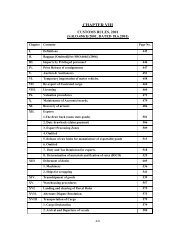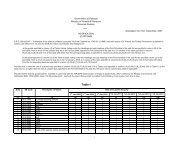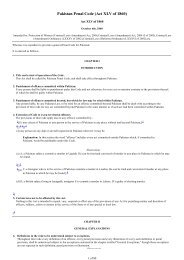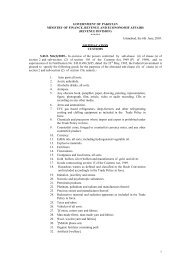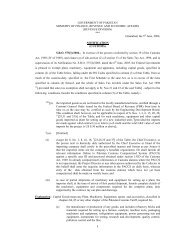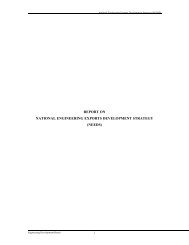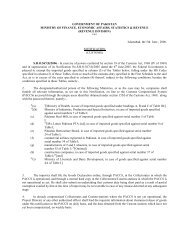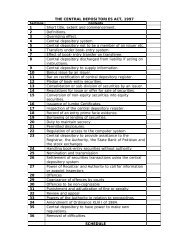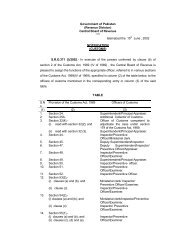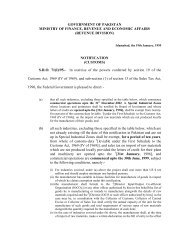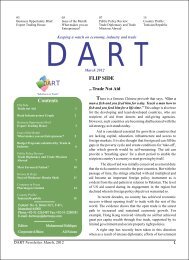47. Pakistan Economic Survey 2011-12 - Consultancy Services in ...
47. Pakistan Economic Survey 2011-12 - Consultancy Services in ...
47. Pakistan Economic Survey 2011-12 - Consultancy Services in ...
You also want an ePaper? Increase the reach of your titles
YUMPU automatically turns print PDFs into web optimized ePapers that Google loves.
Health and Nutritiontook necessary measures to overcome anyemergency situation related to dengue.Drug AbuseIllicit drug consumption, production andtraffick<strong>in</strong>g have emerged as a serious globalissue. Drug abuse has also affected <strong>Pakistan</strong> <strong>in</strong>many ways. Proliferation of drugs andpsychotropic substances with<strong>in</strong> <strong>Pakistan</strong>i societyand the subsequent <strong>in</strong>crease <strong>in</strong> number of drugaddicts are emerg<strong>in</strong>g challenges.A Drug Control Master Plan (2010-14) has beenprepared to reduce the health, social andeconomic cost associated with drug traffick<strong>in</strong>gand substance abuse <strong>in</strong> <strong>Pakistan</strong>. The plan<strong>in</strong>cludes short, medium and long term <strong>in</strong>itiativesfor implementation of the National Anti-Narcotics Policy 2010. The M<strong>in</strong>istry ofNarcotics Control <strong>in</strong> collaboration andcooperation with the prov<strong>in</strong>cial governments andother stakeholders, is tak<strong>in</strong>g measures toeffectively implement the policy.Currently, there are 16 ongo<strong>in</strong>g developmentprojects be<strong>in</strong>g implemented at a total cost ofRs.4.67 billion <strong>in</strong>clud<strong>in</strong>g local cost of Rs.2.13billion and foreign aid of Rs.2.52 billion.Table: 11.6 Drug SeizuresS.No. K<strong>in</strong>d of Narcotics Quantity of DrugsSeized (<strong>in</strong> Kgs)i Opium 8,725.006ii Morph<strong>in</strong>e 1,249.000iii Hero<strong>in</strong> 1,641.014iv Hashish 65,445.850Source: Narcotic Control Division<strong>Pakistan</strong> is one of the top three countries wherethe confiscation rate, seizure of narcotics, drugsand precursor chemicals is high. The seizures ofnarcotics by the Anti-Narcotics Force (ANF)dur<strong>in</strong>g the period July <strong>2011</strong> – 15 th February,20<strong>12</strong> are given <strong>in</strong> the table 11.6:Food and NutritionThe l<strong>in</strong>ks between malnutrition, ill health andpoverty are well known. Disease contributes topoverty due to the costs of illness and reducesearn<strong>in</strong>g capacity dur<strong>in</strong>g and after illness. Goodhealth is a first step towards prosperity andreduction of poverty. It is therefore, critical tomove towards a system which will addresshealth challenges and prevent households fromfall<strong>in</strong>g <strong>in</strong>to poverty due to poor health. In<strong>Pakistan</strong>, health sector <strong>in</strong>vestments are viewedas part of the government’s poverty alleviationendeavors.Food security is a national priority. Accord<strong>in</strong>g tothe recent National Nutrition <strong>Survey</strong> (NNS)<strong>2011</strong>, about 32 percent children under the age offive years and 15 percent mothers areunderweight. About 30 percent babies have lowbirth weight, reflect<strong>in</strong>g the poor nutritionalstatus of mothers.The national food availability estimated throughfood balance sheets, has been satisfactory formajor food items dur<strong>in</strong>g the fiscal year <strong>2011</strong>-<strong>12</strong>.The average calories estimated based on foodavailability has been 2,430 per capita per day.The overall food availability trend of essentialfood items for the last five years is given <strong>in</strong> thefollow<strong>in</strong>g table.The consumption of essential food items showsslight improvement <strong>in</strong> calorie <strong>in</strong>take from 1,650to 1,700 and prote<strong>in</strong> from 44 to 46gm per capitaper day <strong>in</strong> 2010-11 compared to data from theHIES 2007-08. The change <strong>in</strong> food consumptionbetween 2007-08 and 2010-11 has ma<strong>in</strong>ly beenthrough <strong>in</strong>crease <strong>in</strong> cereals: wheat 3 percent, rice<strong>12</strong> percent, pulses 30 percent, vegetable gheeand oil 8 percent, meat 5 percent, fruits andvegetables 11 percent. Consumption decreasedfor sugar (1 percent) and milk (3 percent). Foodconsumption rema<strong>in</strong>ed lower than food availableand the m<strong>in</strong>imum food basket 11 Plann<strong>in</strong>g and Development Division 20<strong>12</strong>159



